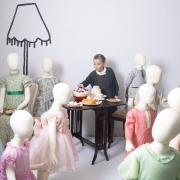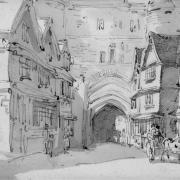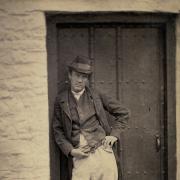It's the sort of story that Hollywood films are made of. A small pocketbook inside the uniform jacket of a private in Gallipoli during the First World War stopped a sniper’s bullet and saved his life.
The soldier, Private Sydney ‘Syd’ Alexander Cross, was injured and was cared for at Knightshayes Court near Tiverton - the National Trust property that became a Voluntary Aid Detachment hospital during the First World War.
Now his story - and the stories of other people who passed through its doors at that time - is being told in a new exhibition.
Remarkable escapes on the battlefield, servant romances and the voices of women after gaining the vote are among the stories featured in the new display, created using research by the National Trust and Findmypast, drawing on data from the recently released 1921 Census.
Private Cross was born in Australia in April 1896 and served in several British regiments during the war. In 1915 on the Gallipoli Peninsula, a sniper’s bullet struck his chest but stopped halfway through a pocketbook, photographs, and papers in his breast pocket.

This ‘miraculous’ incident did not pass by the newspapers at the time, and he was featured in an article in The Western Times in February 1916 where he was shown recovering at Knightshayes, holding the pocketbook and bullet. The pocketbook contained a testament Private Cross had been given as his regiment left England, and the bullet had come to a stop at the words reading: 'A thousand shall fall by thy side, and ten thousand at thy right hand; but it shall not come nigh thee.'
From Knightshayes, Private Cross returned to the Front but in 1917 he was discharged following a bout of malaria. National Trust staff at Knightshayes had no information about his whereabouts following the war, but thanks to the release of the 1921 Census and a new collaboration with Findmypast, some of the next chapter in his life has been revealed.
By 1921 Sydney was married, his wife Elizabeth having completed their census entry. At this time, Sydney was working as a steward for the Cunard Shipping Company. Records reveal further glimpses of his life, with a Sydney Cross recorded in 1926 in Trade Union records as a dining car attendant on the railways, and by the time of the 1939 Register as a waiter in Battersea, London.

Private Cross was not the only soldier recovering at Knightshayes who made the newspapers after a remarkable escape. Described in the same Western Times article as 'a story of modern miracles', Corporal Cooper from the South Staffordshire Regiment was wounded by a shrapnel shell which burst over his trench in Belgium in 1915, leaving him with 119 wounds. He also went on to recuperate at Knightshayes.
In addition to the 1921 Census, researchers have also drawn on two autograph books owned by one of the nurses and an estate worker, containing messages, jokes and drawings made by the soldiers at Knightshayes.
Katie Knowles, assistant national curator for the National Trust said: 'With every new census that is released comes a wealth of detail that we can use to find out more about the people associated with National Trust properties.

'At Knightshayes, which played an important role as a military hospital during the First World War, the 1921 Census has given us the chance to find out what happened to the men who fought, including family members and servants, as well as the nurses who cared for them. Some of the tales, such as the extraordinary escape from death by Private Cross, paint a vivid picture of individuals during the war but now we can learn more about their lives including the social and political changes that affected them.'
Rachael Pett, collections and house manager at Knightshayes Court added: 'I hope visitors will enjoy reading about what happened to some of the people connected to Knightshayes – or may even know about or be related to them and can help us uncover more – and will be inspired to start researching their own family history as a result.'
The Knightshayes display is open seven days a week. It has been created with research by National Trust curators and other staff and experts from Findmypast where the 1921 Census records can be accessed.
nationaltrust.org.uk/knightshayes



























